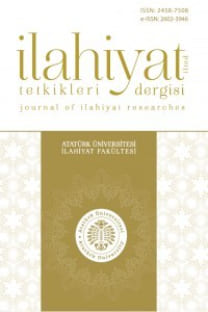Elias Wang and His Method of Interpretation İlyas-Wang ve Tefsir Yönteminin Analizi
This study aims to introduce the life of Elias Wang, a famous Chinese scholar, and explains his interpretation method. First, it introduces his birth, growing process, academic works, and main points. Secondly, it focuses on the interpretation method he adopted in order to help the Muslim public in China to benefit from Quran’s universal guidance. The findings suggest that Elias Wang, who grew up in a Muslim family, was well educated and well versed in Arabic and Islam. Thus, he could properly understand the meaning of Quran thanks to it. He tried his best to serve Hui ethnic group in China all his life and achieved satisfactory results in translating Hui classics and writing Hui books. The research also shows that he follows correct method in Quran interpretation, which ensures the correctness of the interpretation content. The interpretation method is based on the following points: flexible footnote method is adopted in interpretation; great attention is given to various problems encountered by the Hui people in China’s religions, society, and culture, and the solution he offers guides readers to the connotation of Quran. The interpretation content is taken from the most authoritative Arabic annotated classics and frequently quoted stories and legends that appear in the major interpretation classics.
Anahtar Kelimeler:
Interpretation of the Qur, Interpreter, Elias Wang, Interpretation in Chinese, Method of interpretation
___
- Ba’lekî, Munîr. “Mukaddimetü’l-Mütercim”. Hayatü Muhammet ve Risâletihî li-Muhammet Aliyy’i-Lâhurî. Beyrut: Dâru’l-İlm, 1390.
- Bai, Shouyi. Târîhü’l-Müslimîn fî’s-Sin. Pekin: Dâru’l-Zhonghua, 2. edition, 2003.
- Beyzâvî, Abdullah b. Omar. Envârü’t-tenzîl ve esrârü’t-teʾvîl. Beyrut: Dâru İhyâü’t-Türâsi’l-Arabî, 1963.
- Halvetî, Ebü’l-Fidâ İsmail Hakkı b. Mustafa. Rûḥu’l-beyân fî tefsîri’l-Ḳurʾân. Beyrut: Dâru’l-Fikr, 1431.
- Herevî, Muhammad el-Emîn. Hadâiki’r-Revhi ve’r-Reyhân fî Ravâbî Ulumi’l-Kur’ân. Beyrut: Dâru Tavku’n-Necât, 2001.
- Kurtubî, Şemseddîn Muhammed b. Ahmed. el-Câmiʿ li-aḥkâmi’l-Ḳurʾân. Kahire: Darü’ l-Küt übi’l -Mısr iyye, 1963.
- Lin, Song. Kur’ân-ı Kerîm fî-s-Sin. Ningxia: Dâru-ş-Şa’b, 2. edition, 2007.
- Ma, Ping. Târîhu’l-İslâm el-Muhtasar fi’s-Sin. Ningxia: Dârü’ş-Şa’b, 2010.
- Taberî, Ebû Ca’fer Muhammed b. Cerîr. Câmiʿu’l-beyân ʿan teʾvîli âyi’l-Ḳurʾân. Kahire: Darü İbnü’l-Cevzî, 2015.
- Wan, Yao Ping. el-Me vsûat ü’l-İ slâmi yyetü ’s-Si niyye . Sichuan: Daru’t-Taba’a ve’n-Neşr li’l-Meâcim, 2. edition, 2007.
- Wang, Genming. el-Üstâz Wang ve Fikruhü fî Hubbi’l-Vatan. Mecceletü Dirâsâtü’l-Kavmiyyât 2/97 (2018).
- Wang, Ilyas. Tercümetü Meâni’l-Kurâni’l-Kerîm ve Tefsîrihî. Chung Tenching: Daru Yongxiang, 1946.
- Yang, Huaizhong. Ta’rîf li’l- Kütüb i’l-İ slâmi yetti ’s-Si niyye . Ningxia: Dâru'ş-Şa’b, 1993.
- ISSN: 2458-7508
- Yayın Aralığı: Yılda 2 Sayı
- Başlangıç: 1975
- Yayıncı: Atatürk Üniversitesi İlahiyat Fakültesi
Sayıdaki Diğer Makaleler
Elias Wang and His Method of Interpretation İlyas-Wang ve Tefsir Yönteminin Analizi
Tasavvufî Sembolizm Açısından Mevlevî Semâ Âyini
Sonsuz ile Sonlu Olanın Sürekliliği: Eş‘arî Kelâmında Bekâ Tartışmaları
İran'da Faaliyet Yürüten Nakşibendî- Hâlidî Şeyhlerinin Sünnî Kültüre Katkısı
“Ben”i Aramak İçin Bir Yolculuk: Şebüsterî’nin Gülşen-i Râz’ında “Ben” Kavramı
Rasoul RAHBARI GHAZANI, Saliha UYSAL
El-Melikü’z-Zâhir Baybars’ın Sultanlığı Meselesi: Sultan Öldüren Sultan Olur mu?
